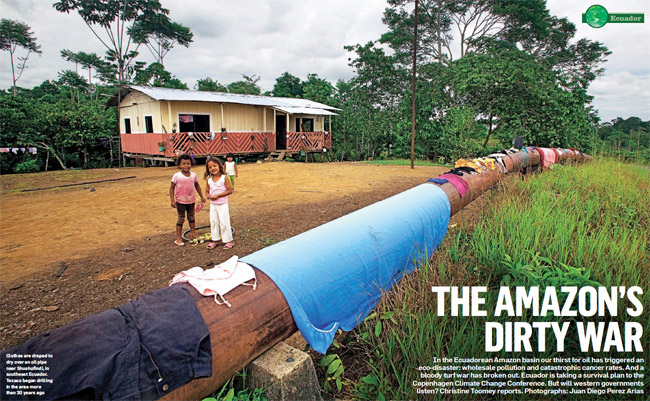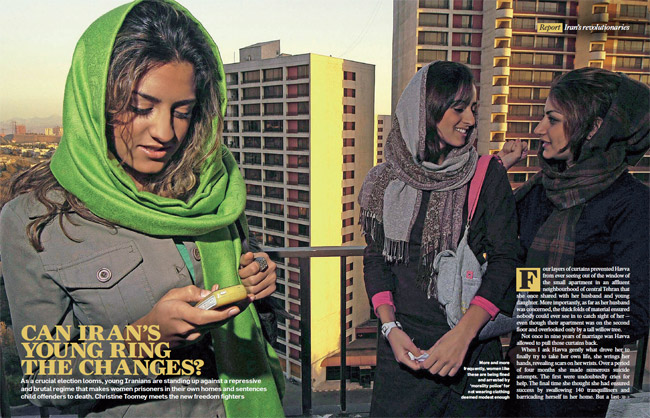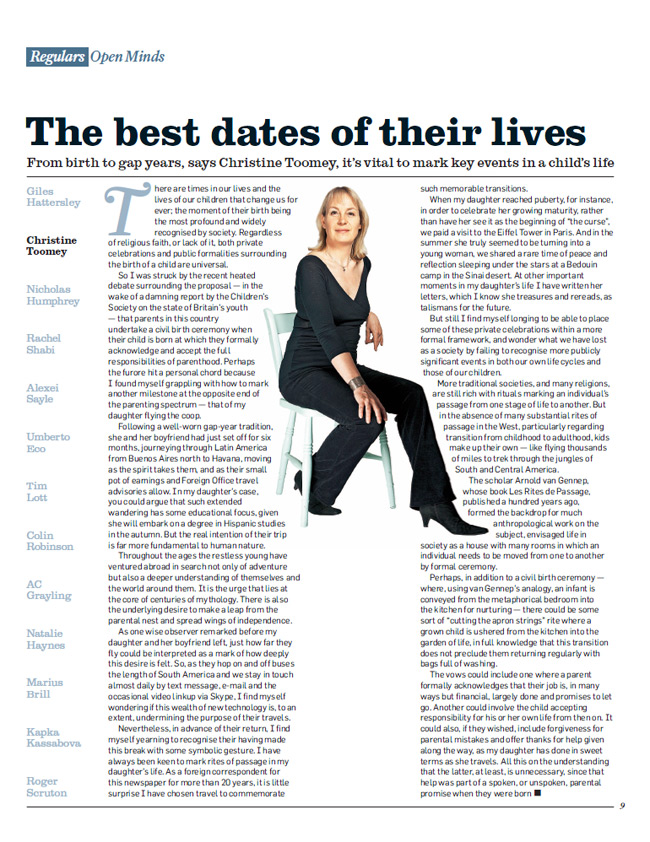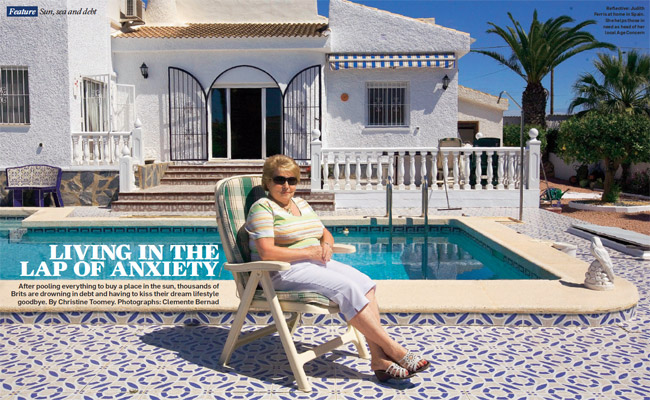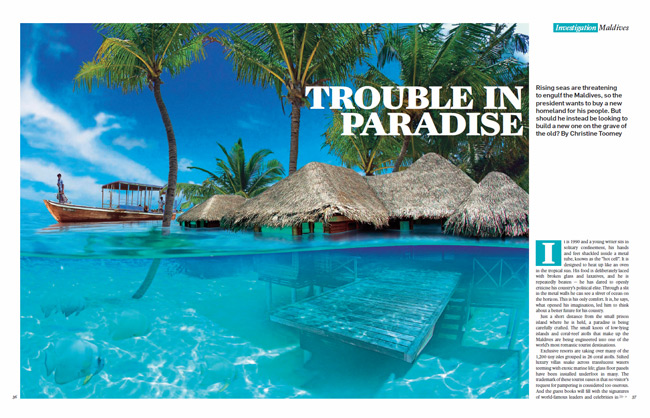 1st May, 2011
1st May, 2011
DNA tests may reveal the truth about the adopted children of an Argentinean media tycoon. Were they stolen during the country’s ‘dirty war’? Christine Toomey investigates.
The sleek neighbourhood of Martinez in the north of Buenos Aires had never seen anything like it. Police cars slewing across the road after giving chase from a nearby courtroom. Federal agents in combat gear spilling onto the streets. Press photographers swarming around the frightened figures of two of Argentina’s most prominent media scions.
Those who live in the sprawling mansions here are accustomed to being chauffeured to and fro in limousines with darkened windows to protect their identity. But on the morning of May 28 last year, all rights to privacy were stripped from the adopted son and daughter of one of South America’s wealthiest media moguls, Ernestina Herrera de Noble, head of the multibillion-dollar media conglomerate Grupo Clarin.
Marcela and Felipe Noble Herrera were forced out of their car at the gates of their mother’s estate and bundled into her home under armed guard. They were then ordered to undress in front of at least seven officials. When it came to removing their underwear, the brother and sister, then both 34, were escorted to separate bathrooms. But, still under observation, they were forced to strip naked. Court officials sealed the siblings’ clothes in plastic bags, together with other personal items such as toothbrushes, combs and a pair of Felipe’s slippers.
With Felipe in tears, the siblings were told that their personal effects were being taken away for DNA testing on the orders of the court, contrary to their wishes, in an attempt to trace their biological origins. More specifically, to determine whether, as is alleged, they could be among the hundreds of Argentinians stolen as babies from parents arrested by the military dictatorship during the brutal 1976-1983 “dirty war” against suspected dissidents and subversives, and “disappeared” — the euphemism coined during those dark years for mass murder.
“In a normal country, a normal judge would have summoned Marcela and Felipe and listened to what they had to say. Instead she authorised evidence to be taken in such a way it left them traumatised,” says the siblings’ indignant lawyer, Alejandro Carrio, who witnessed their humiliation. “They both feel caught in the middle of a battle that has so many political overtones. It is all spectacularly unfair.”
But these are not normal times in Argentina. After more than two decades during which military henchmen behind some of the worst war crimes imaginable have luxuriated in comfortable retirement, the country’s current president — Cristina Fernandez de Kirchner — is determined to bring those responsible to book. To most Argentines, the details of the depths of depravity to which the military regime sank during those years are sickeningly familiar. After arresting and torturing those they dubbed “subversives” — in many cases students, intellectuals or union members whose names were simply in the wrong address book — many thousands were loaded onto military aircraft, stripped naked and hurled to their deaths in the South Atlantic.
On February 28, eight military men, including General Jorge Rafael Videla, who once ruled the country as de facto president, went on trial in Buenos Aires charged with systematically stealing babies from parents murdered for their suspected left-wing sympathies. The majority of those killed were young adults. Many of the women were pregnant or mothers with small children who were abducted with them. Those infants not killed at the same time as their parents were handed over to sympathisers of the regime, in many cases childless military officers and their wives, who brought the children up as their own, changing their identities so they had no idea of their origins.
Of the estimated 500 babies and children abducted in this way, 102 have so far recovered their true identities after a tireless campaign by a group of their grandmothers, known as the Grandmothers of the Plaza de Mayo, who never gave up hope of one day tracking down their stolen grandchildren. Some were traced to the homes of those who had illegally adopted them, after years of detective work by the Grandmothers acting on tip-offs from suspicious neighbours, teachers or doctors, and were restored to their biological families when they were still young. Many others only discovered the truth as adults. In the most harrowing instances, some had to face the appalling reality that they had been born in clandestine torture centres where their mothers were kept alive only long enough to give birth, so that their newborns could be snatched from their arms and, in some cases, raised by those directly responsible for their parents’ deaths.
This last nightmarish scenario could not have been the case with Marcela and Felipe, if official records are to be believed. According to court documents at the time, both were adopted within six months of the March 1976 military coup — before the junta’s murderous machinery had swung into full gear. These papers state that Marcela was left in a cardboard box on Ernestina Herrera de Noble’s doorstep at the beginning of May 1976, while Felipe is said to have been handed to Herrera de Noble when she went to court to submit papers to adopt Marcela in July of that year — the baby boy apparently having been abandoned by a single mother unable to look after him. Within a month, both newborns were registered as the legally adopted children of Herrera de Noble, already by then a powerful businesswoman with close links to the military regime following the death of her publishing impresario husband.
But a 2002 court investigation into the legality of the siblings’ adoption, instigated by the Grandmothers of the Plaza de Mayo, found nobody in Argentina by the name of the woman said to have abandoned Felipe. Meanwhile, a man said to have witnessed Marcela being found on Herrera de Noble’s doorstep was revealed as a long-time employee of Grupo Clarin. The discoveries led to the brief arrest of Herrera de Noble that year on suspicion of knowingly adopting children of the disappeared — an allegation she has consistently denied.
The charges were later dropped for lack of evidence. But in a statement after her release Herrera de Noble admitted she had been open with her children as they were growing up that “they and their parents may have been the victims of illegal repression” — an admission the Grandmothers have since used to press for the siblings’ genetic testing. If DNA matches were to reveal Marcela and Felipe were stolen children of the disappeared, and if it were proven that they were knowingly adopted as such by Herrera de Noble, the 85-year-old publisher could face criminal charges carrying a lengthy jail term.
Herrera de Noble claims investigations into the biological origins of her adopted children are politically motivated, driven by revenge on the part of the country’s president because of opposition to her regime in recent years by Grupo Clarin, which includes the country’s largest circulation daily newspaper, Clarin.
For their part, Marcela and Felipe say they have no interest in discovering their true origins because they are happy with Herrera de Noble as their mother. Although they both live independently now — Felipe is married with a young child, Marcela is divorced — both work as executives with Grupo Clarin. In one of the very few public statements they have made about the dispute, they complain of “being treated like criminals, though we have committed no crime”. “For the last 34 years we have lived with the blessing of a mother who chose us as her children and we chose her as our mother. Nothing and no-one can destroy that bond,” Marcela said in a rare television address, with her brother Felipe wringing his hands at her side.
Yet after forensic tests carried out on the siblings’ seized clothing concluded it had been contaminated with DNA traces from other people, courts ordered Marcela and Felipe to subject themselves to compulsory donation of blood, saliva, skin or hair samples, which they are refusing to do — despite having voluntarily given similar samples back in 2009, which were said by a former judge to have also been contaminated. Their lawyers argue that the latest court order requiring compulsory donation is an illegal invasion of their personal and physical integrity. The reclusive siblings contend that their biological identity is a personal matter and are preparing to take their fight as far as the Supreme Court.
At the heart of this continuing battle is a profound moral and legal conundrum. On the one hand is the right of children, now adults, to choose not to know their biological origins; on the other is the right of grandparents to attempt to restore the identity of those they believe could be the stolen offspring of their own children. Caught between these intensely emotional, conflicting interests is the obligation of the state to see that
Forty miles to the south of Buenos Aires, in the provincial town of La Plata, one grandmother is in no doubt about the rightful solution to this dilemma. Chicha Mariani, 86 and now nearly blind, sits surrounded by photographs of her murdered son, Daniel, daughter-in-law, Diana, and their smiling three-month-old baby, Clara Anahi, for whom she has spent the last 34 years searching. The fate of her son and daughter-in-law are beyond dispute. Diana died in a hail of bullets when the family’s home on the outskirts of La Plata came under army attack, including by helicopter gunships, on the morning of November 24, 1976. Under the guise of running a small meat-packing operation, she and Daniel had allowed their home to be used to house a secret printing press for a left-wing guerrilla group known as the Montoneros.
Eyewitnesses later testified that they saw Diana shot in the back and legs as she ran, with her baby in her arms, from the burning house. But while her charred remains and those of three other militants were later recovered, no trace was ever found of Clara Anahi. One witness says she saw the baby being bundled away in the arms of a man in uniform. Chicha’s son was shot on the street the following year.
On Chicha’s wall is a photograph of Clara Anahi propped up in a baby seat, wearing a pink woollen outfit. “I knitted that for her when she was born,” Chicha recalls, her face lighting up for an instant. “She was with me for just three months. But she is still part of me. For the little life I have left, my only wish is to see her once more, hold her in my arms and tell her about her parents.”
Even during the dictatorship, in defiance of the generals, Chicha and other Grandmothers of the Plaza de Mayo ignored the ban on public gatherings and started assembling weekly in the central square of Buenos Aires, marching silently in white headscarves, carrying pictures of their missing sons and daughters.
It was during these repressive years that Chicha first suspected that her grandchild might have been passed to Ernestina Herrera de Noble to raise as her adopted daughter, Marcela. In the years after adopting Marcela and Felipe, photographs of the media magnate and the children would sometimes appear in the pages of her flagship daily, Clarin. “When I saw those early photographs of Marcela, there was something about her I recognised,” says Chicha. “Even now when I see photos of her I see certain characteristics that are similar to mine — the way she holds her hands, the shape of her legs.” But there is more to it than that.
In the first desperate months after Clara Anahi disappeared, Chicha went knocking on the doors of senior figures in the Catholic Church, both in La Plata and Buenos Aires, asking for help in tracing her granddaughter, but was quickly told to stop looking because the infant was “untouchable” and, by then, “in the hands of a very powerful person”. Some Catholic clerics have since been convicted of colluding with the military in covering up crimes committed during the dictatorship.
Despite her suspicions, Chicha did not act on them for many years, not only because the prevailing political climate made progress difficult, but also because her granddaughter disappeared months after records showed Marcela was adopted. When investigations revealed errors and obfuscations in both Marcela and Felipe’s adoption papers, the veracity of the date on which they were signed was also called into question and the Grandmothers’ petition that the siblings submit to DNA testing led to years of legal wrangling.
Chicha admits she is losing hope. “For the past 35 years I have continued to believe I would one day hold my granddaughter in my arms again. But now, because of my age, I’m beginning to doubt it. All those years my love for my son and his family kept me going, maybe my anger fed me too. But now I can hardly see or hear. I don’t have the force I once had. It is very hard,” says Chicha, who eventually separated herself from the Grandmothers to found her own organisation, Asociacion Anahi, dedicated to the search for her granddaughter.
With unlimited financial resources, however, lawyers for the Noble siblings are determined to fight to the bitter end any court orders relating to DNA testing. For Chicha Mariani is not the only one to suspect Marcela could be her granddaughter. Another family also believes that Ernestina Herrera de Noble’s adopted daughter bears a striking physical resemblance to the mother of their missing granddaughter, Matilde Lanuscou. Barbara Miranda and Roberto Lanuscou, both Montoneros, died in a shootout with soldiers in September 1976, along with two of their three children, aged four and five. Six-month-old Matilde was said to have died with them, but during an investigation after the dictatorship ended, Matilde’s coffin was found to contain only baby clothes and a dummy. Photographs of Matilde’s mother, Barbara, in her twenties show she shares very similar looks to Marcela.
It is believed Felipe, meanwhile, could be the son of Maria Gualdero, who was 20 years old and nine months pregnant when she was seized by security forces in June 1976, though her family is reluctant to discuss the case publicly. In an effort to bring the legal wrangling to an end, Marcela and Felipe did agree seven years ago to their DNA being tested against that of the Miranda and Gualdero families, though not that of Chicha, who appealed to them separately.
When the Grandmothers insisted that, if no match were found in these two instances, their DNA should be kept on record so that testing could be expanded in future to include all those families in the National Genetic Data Bank, the siblings’ lawyers dug their heels in and prevented the DNA testing from going ahead. Since this data bank, originally set up as an independent organ at the insistence of the Grandmothers, now falls under state jurisdiction, they argue its results could be manipulated by the government. “They are afraid if their genetic map ends up in that data bank, it could be the basis for
Lawyers for the families of the disappeared, on the contrary, believe it is the siblings who are trying to delay court proceedings for as long as possible. “The legal strategy of Grupo Clarin is to drag this out until Ernestina dies to avoid the possibility of her facing any kind of trial,” argues Pablo Llonto, who represents the Lanuscou family. To those stolen children who have recovered their identities, however, the lengths to which Marcela and Felipe are prepared to go to protect their adoptive mother are entirely understandable.
Even those who have discovered the most shocking truth of all about their origins, and whose cases form the basis of the current trial against Videla and his henchmen, sympathise with the dilemma the siblings face.
“I believe there are many similarities between what happened to me and what is happening now with the Noble children,” says Pedro Sandoval, who was 29 when he discovered, in 2006, that his whole life to that point had been a lie. Pedro was raised with the name Alejandro Rei and believed he was the natural son of a military policeman called Victor Rei and his wife. When Rei was arrested in 2004 on suspicion of having appropriated a stolen child, Pedro was convinced of Rei’s innocence. But his DNA confirmed he was the son of a murdered 32-year-old union activist, Pedro Sandoval, and his 20-year-old wife, Liliana Fontana. Liliana was five months pregnant when she was arrested in July 1977 and gave birth to him in a secret detention and torture centre before she was killed.
Yet even when he knew the truth, Pedro testified in favour of his abductor at a trial in which Rei was sentenced to 16 years in prison, saying how well cared for and loved he had felt as a child. “It was only at the end of the trial that the reality of what had happened sunk in,” he says. “I believe I was suffering from a severe form of Stockholm syndrome, completely unable to think for myself while I was still under the influence of those who abducted me.” Pedro believes the Noble siblings could be suffering in the same way. “It is much harder the older you are.”
Another recovered grandchild who understands this only too well is Victoria Montenegro, who was 25 and married with three children when she discovered the man she had grown up believing was her father was in fact the person who had shot her real parents dead. Victoria was only 13 days old when the house where her parents, Hilda Torres and Roque Montenegro, lived on the outskirts of Buenos Aires was stormed by soldiers under the command of the army colonel Hernan Tetzlaff, who, together with his wife, went on to raise her under a false date of birth and the name Maria Sol Tetzlaff.
After a tip-off about her real identity, the Grandmothers filed a petition with the courts that eventually led to her being forced to submit to a blood test that confirmed their suspicion in 2001. “The first thing I felt when they gave me the result of the tests was a terrible shame that I was the daughter of subversives. Then immediately I became afraid that my father would not love me any more,” says Victoria, who, despite everything she now knows at the age of 35, continues to call Tetzlaff her father. A large framed photograph of Victoria as a young child perched on his shoulders, gently clutching his cheeks, stands on the bookshelf in her home. “I can’t lie to myself. I loved him very much,” she says picking up the picture of Tetzlaff, who died in jail.
It took Victoria five years to accept her real identity and change her name from Maria Sol. “I didn’t want to know the truth. I didn’t want to see the man who had raised me go to prison. I felt that by giving my blood for DNA testing, that gesture of extending my arm for the needle, made me responsible for someone I had spent my whole life loving ending up in jail.”
It was partly in order to take away any misplaced feelings of culpability, but also to speed up the process of stolen children recovering their true identity, that a law was passed in November 2009 making it compulsory for those suspected of being children of the disappeared to submit to DNA testing whether they wish it or not. It is the constitutionality of this legal obligation that the Noble siblings are determined to fight as far as the Supreme Court.
There are some Grandmothers who agree, however, that a compulsory blood test is going too far. “By forcing someone to have a needle stuck in their arm against their will, you are in danger of using the same repressive attitude that our own children suffered as a result of. There are other ways of obtaining DNA that are not as intrusive,” says Elsa Pavon, whose daughter and son-in-law are among the disappeared, but whose granddaughter, Paula, was found living with a senior police officer and his wife and returned to her when the child was just eight years old. Yet Paula’s true identity was also confirmed as a result of a blood test, and Paula herself does not question this. “I think the state has the right to know. The truth is the truth, and there is no going back from that,” says the 35-year-old mother. She has two young daughters, to whom she has yet to explain the circumstances in which she lived as a child. “When they are old enough I will talk to them about it. But these things are very hard for children to understand.”
Twelve years ago, when I first wrote about the children of the disappeared, I was haunted by the words of one psychologist who worked with the Grandmothers of the Plaza de Mayo. “The aim of the military, in abducting babies and annihilating their real identities, was to institute a form of state terrorism that would operate over generations,” said Dardo Tumas. “What the military did was introduce a form of poison that continues to seep through this society.”
This is precisely why the state has a duty to make DNA testing mandatory, argues the lawyer Pablo Llonto. “It is the obligation of the state to protect the rights of future generations,” he contends. “Identity is not just a matter for the individual, whose right to privacy can be protected if it affects just that person. But what has happened in Argentina is something that will affect generations to come, including the children of those who were stolen as babies.”
Chicha Mariani’s gentle face hardens for a moment when I ask if she feels those suspected of having been abducted as babies should be forced to submit to genetic testing against their will. “If it was your grandchild who was stolen, would you be asking that question?”

